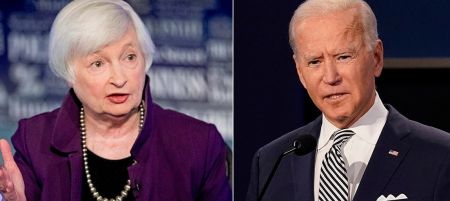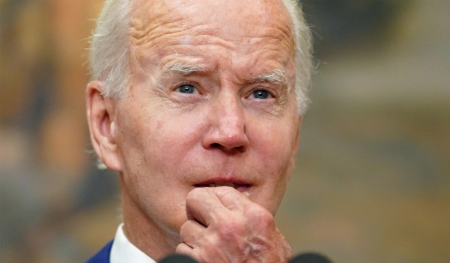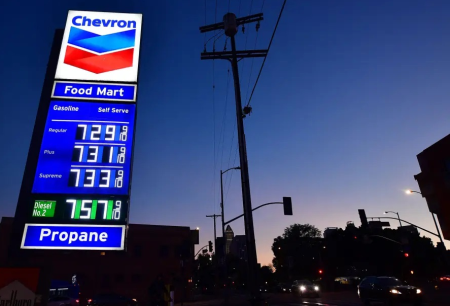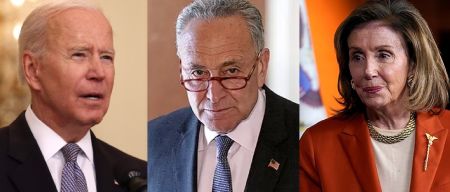Biden's, Democrat's dominant theme will be, “It’s Not a Recession, We Swear!”
WASHINGTON, D.C. (Texas Insider Report) — On yesterday morning's 'Meet the Press' weekend political talk show, Joe Biden's Secretary of the Treasury Janet Yellen had the unenviable task of trying to convince an already hurting American Public that even though it may look like a recession, sound like a recession, and feel like a recession, it’s not really a recession:
SEC. JANET YELLEN: I do want to emphasize: What a recession really means is a broad-based contraction in the economy. And even if that [2nd quarter GDP growth] number is negative, we're not in a recession now. And I would, you know, warn that we should be not characterizing that as a recession.
 CHUCK TODD: I understand that, but you’re splitting hairs. If the technical definition is two quarters of contraction, you’re saying that’s not a recession?
CHUCK TODD: I understand that, but you’re splitting hairs. If the technical definition is two quarters of contraction, you’re saying that’s not a recession?
YELLEN (at right): That’s not the techno...
TODD: No?
YELLEN: That’s not the technical definition. There’s an organization called the National Bureau of Economic Research that looks at a broad range of data in deciding whether or not there is a recession. And most of the data that they look at right now continues to be strong. I would be amazed if the NBER would declare this period to be a recession, even if it happens to have two quarters of negative growth.
 CHUCK TODD: I understand that, but you’re splitting hairs. If the technical definition is two quarters of contraction, you’re saying that’s not a recession?
CHUCK TODD: I understand that, but you’re splitting hairs. If the technical definition is two quarters of contraction, you’re saying that’s not a recession?YELLEN (at right): That’s not the techno...
TODD: No?
YELLEN: That’s not the technical definition. There’s an organization called the National Bureau of Economic Research that looks at a broad range of data in deciding whether or not there is a recession. And most of the data that they look at right now continues to be strong. I would be amazed if the NBER would declare this period to be a recession, even if it happens to have two quarters of negative growth.
In a week full of big economic-news releases, on Thursday morning the U.S. will learn if we’ve experienced two consecutive quarters of the Gross Domestic Product (GDP) shrinking – which is the traditional definition of "a recession."
- Political & Economic Analysts will be studying the Consumer Confidence Index numbers released on Tuesday.
- The Federal Reserve is expected to increase interest rates another .75% on Wednesday.
- But the most significant numbers released this week come at 8:30 a.m. (Eastern time) Thursday morning when the Nation's 2nd Quarter economic growth figures are announced – and they’re not expected to be positive.
- The Atlanta Federal Reserve Bank has already indicated that U.S. GDP shrank 1.6% in the last quarter.
- The 1st Quarter of 2022 saw a decline of 1.6% as well – so if the Atlanta Fed's projection is even close to being correct, Thursday morning will bring news that the U.S. is now in a recession.
 Secretary Yellen and other Biden White House officials are already arguing that we’re not in a recession – which seems like a clear hint that they expect Thursday’s numbers to be ugly.
Secretary Yellen and other Biden White House officials are already arguing that we’re not in a recession – which seems like a clear hint that they expect Thursday’s numbers to be ugly.To the average American, “recession” is a synonym for “economic hard times” – and with inflation now at a 40-year high of 9.1%, and with gas prices at similar record levels, millions of Americans feel like President Biden and the Democrat's policies do, in fact, already have the country in a "recession."
And while it may be true that it’s odd to see an economic recession when unemployment sits at just 3.6%, and when 11.3 million jobs as said to remain unfilled across the United States, an unfilled job doesn’t actually produce anything – and all those empty office cubicles, the empty spots on the assembly line and the unanswered job-search calls feel a lot more like a sign of economic weakness.
There are still a lot of, “Please be patient, we are understaffed” signs in the front of restaurants around the country, a lot of retail stores with only one or two registers open, and a lot of pharmacies with only one pharmacist trying to manage the phone and the line of customers in front of her.
Those aren’t signs of a thriving economy.
The U.S. Chamber of Commerce recently noted:
The U.S. has 3.25 million fewer Americans working today compared to February of 2020... Right now the latest data shows we have over 11 million job openings in the U.S. — but only 6 million unemployed workers. We have a lot of jobs, but not enough workers to fill them. If every unemployed person in the country found a job, we would still have 5.4 million open jobs.
If the economy were as strong and healthy as the Biden White House and Congressional Democrats say it is, most Americans feel there would be some of their neighbors working in those jobs.
And at the same time, the average driver in the U.S. is now paying nearly $275 a month at the pump – up from $167 in June 2021 when a gallon of gas was $3.07 (according to Kelley Blue Book’s calculations.)
 With interest rates increasing and set to move even higher this week when the Federal Reserve Bank is expected to announce another substantial interest rate hike, mortgage payments and rent are escalating as well. The median monthly rent during May was up 26% from 2019 to nearly $1,850 according to Realtor.com.
With interest rates increasing and set to move even higher this week when the Federal Reserve Bank is expected to announce another substantial interest rate hike, mortgage payments and rent are escalating as well. The median monthly rent during May was up 26% from 2019 to nearly $1,850 according to Realtor.com.
 With interest rates increasing and set to move even higher this week when the Federal Reserve Bank is expected to announce another substantial interest rate hike, mortgage payments and rent are escalating as well. The median monthly rent during May was up 26% from 2019 to nearly $1,850 according to Realtor.com.
With interest rates increasing and set to move even higher this week when the Federal Reserve Bank is expected to announce another substantial interest rate hike, mortgage payments and rent are escalating as well. The median monthly rent during May was up 26% from 2019 to nearly $1,850 according to Realtor.com.In the American public’s mind, a recession is de facto synonym for “bad economic times” – and with inflation at 9.1% and expected to move higher, Americans are feeling an intense financial squeeze because everything is more expensive – particularly groceries and gasoline.
These are noticeable price hikes in everything the average American buys, and the price hikes aren’t or haven't been gradual; they’re sudden and noticeable.
Said The New York Times in mid-July:
“Just 10 percent of registered voters say the U.S. economy is ‘good’ or ‘excellent,’ according to a New York Times/Siena College poll – a remarkable degree of pessimism at a time when wages are rising and the unemployment rate is near a 50-year low.”
But in May 2021:
- the average price of a dozen large eggs was $1.60. A year later it was $2.80 – an increase of 75%.
- Ground beef is up 13% per pound.
- A gallon of whole milk costs 20% more.
- Grocery prices were 12% higher overall last month than they were a year earlier, according to the Bureau of Labor Statistics.
- That was the largest year-over-year increase since 1979.
 Between now and the fast approaching Mid-Term Elections, Ms. Yellen, Mr. Biden, and the rest of the Democrat Party may try to convince the reeling American public that the nation is not in "a recession" and that they are, in fact, more prosperous than they feel – the evidence is mounting, shouting to the contrary.
Between now and the fast approaching Mid-Term Elections, Ms. Yellen, Mr. Biden, and the rest of the Democrat Party may try to convince the reeling American public that the nation is not in "a recession" and that they are, in fact, more prosperous than they feel – the evidence is mounting, shouting to the contrary.President Joe Biden and his fellow Democrat Party candidates across the country face a daunting – and likely impossible challenge to explain to the American people why it’s not true.























